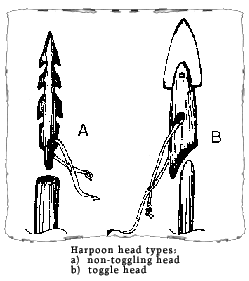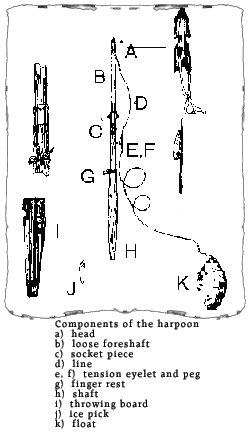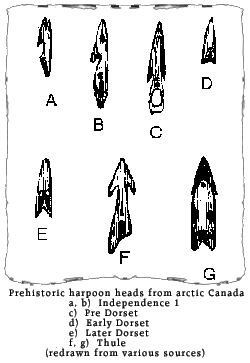
 While
modern technology has replaced many of the traditional tools
that enabled Inuit to survive in the Arctic, one of their
fundamental hunting weapons, the harpoon, continues in use
to the present day. Essentially, the harpoon is a spear designed
to secure a detachable point, or head, to an animal; a line
attached to the head allows the hunter to retrieve the quarry
once it has been struck. Harpoons have a wide distribution
throughout the world, but it is among the Inuit that the most
complex pre-industrial forms were developed. The primary use
of the Inuit harpoon was for hunting sea mammals, both at
breathing holes in the sea ice and in open water, although
in some arctic areas the harpoon was used for fish as well. While
modern technology has replaced many of the traditional tools
that enabled Inuit to survive in the Arctic, one of their
fundamental hunting weapons, the harpoon, continues in use
to the present day. Essentially, the harpoon is a spear designed
to secure a detachable point, or head, to an animal; a line
attached to the head allows the hunter to retrieve the quarry
once it has been struck. Harpoons have a wide distribution
throughout the world, but it is among the Inuit that the most
complex pre-industrial forms were developed. The primary use
of the Inuit harpoon was for hunting sea mammals, both at
breathing holes in the sea ice and in open water, although
in some arctic areas the harpoon was used for fish as well.
Traditional Inuit harpoons exhibited
a wide range of form. To the basic elements of the harpoon,
namely the shaft, head and line, were added other devices,
and each component could have been refined in a number of
ways to make the harpoon suitable for hunting under specific
conditions.
Harpoon heads generally belonged to one
of two major groups. One kind had a projecting tang at its
base, which was inserted into a socket piece on the end of
the shaft. Barbs projecting from the body of this type of
head ensured that it stayed embedded in the flesh of the animal
once it was harpooned. The other variety had a socket at the
base of the head to receive the tip of a foreshaft. After
being thrust into an animal, one or more spurs at the base
of the head dug into its flesh; tension on the harpoon line,
which passed through a hole above the socket, then caused
the head to rotate 90 degrees, preventing it from slipping
out. This variety, called the toggle harpoon head, was the
more common form in Inuit cultures. Some toggle harpoon heads
also had barbs, perhaps as added insurance that the head would
not pull out if it had not penetrated deeply enough for the
spurs at the base to dig in. Harpoon heads of either kind
were self-pointed or might have been tipped with separate
bone, stone or metal blades.
The thick hide of the bearded seal was
favoured by many groups for making harpoon lines. The tangs
of non-toggling heads were held in the harpoon socket by friction.
Toggle harpoon heads, on the other hand, were held in place
at the end of the foreshaft by tension on the harpoon line,
which was stretched back to the shaft and secured by an eyelet
that slipped over a peg set into the shaft. Hunters using
the harpoon at breathing holes normally held onto the end,
whereas when hunting from boats a float was usually attached
to the line to tire the animal out. Floats for harpoons ranged
in size from small ones made out of bladders to large floats
made from the entire skin of a seal. Foreshafts for toggle
harpoon heads were "fixed" or "loose".
Fixed foreshafts were fastened securely to the shaft. Harpoons
with fixed foreshafts have traditionally been associated with
hunting at breathing holes, where the harpoon was thrust with
considerable force and then pulled back, releasing the head.
Loose foreshafts were designed to move laterally once an animal
had been struck, shortening the distance between the head
and the tension eyelet and thereby allowing the head to detach.
There were various ways that this could be achieved, but most
commonly the loose foreshaft had a rounded butt that fit into
a shallow socket at the end of the shaft. A thong passing
through one or more holes near the base of the foreshaft fastened
it either to the socket piece or to the shaft in such a manner
that the foreshaft could pivot. Although there were no firm
rules in this regard, loose foreshaft harpoons were often
used in open water hunting. In these situations the harpoon
was usually thrown at a swimming sea mammal, and the movement
of the foreshaft ensured that the head would separate.

The harpoon shaft was made of wood, if
available, as it would then float. In areas where wood could
not be obtained, the shafts were fashioned from narwhal tusk
or from several pieces of bone or antler spliced together.
The size and weight of the shaft depended upon the manner
in which it was used. Harpoons used for hunting at breathing
holes were generally short and light, whereas longer and heavier
shafts were used for walrus and whales. Ice-hunting harpoons
usually had an antler or ivory pick or chisel lashed to the
butt end to enlarge the breathing holes so that seals could
be pulled through, although some throwing harpoons had ice
chisels as well. Either kind may have had a finger rest attached
to the shaft to provide extra leverage. In some areas, harpoons
used for open water hunting were cast using throwing boards,
which could propel them faster than throwing by hand alone.
Archaeological evidence shows that harpoon
technology has been known in the Arctic for thousands of years.
There has been considerable change in harpoon apparatus over
time as they were refined to make them more efficient or altered
to make them better suited for certain purposes. Purely stylistic
changes appear to have occurred as well. These changes are
particularly evident in harpoon heads, where the presence
and position of barbs and blades, the position of the line
hole, the nature of the socket and provision for securing
it to a foreshaft, the shape and location of spurs, and a
variety of other attributes often reveal the age and cultural
affiliation of a particular specimen.
It is not always evident, however, what
kinds of hunting strategies were used in prehistoric times.
The Independence I (400 - 3700 B.P. [Before Present]) and
Pre-Dorset (3700 - 2800 B.P.) peoples in the Canadian Arctic
probably used harpoons with fixed foreshafts. In the Dorset
period (2800 - 1000 B.P.) foreshafts appear to have been attached
to the shaft in such a way that they moved backwards on the
shaft on impact, loosening the harpoon head. The Thule culture
(1000 B.P. - historic period) added the loose foreshaft to
the repertoire. This may indicate that the earliest inhabitants
of the area hunted only at breathing holes and that open water
hunting was a later innovation, or it may simply reflect a
development from an all-purpose form to specialized harpoons
for particular hunting conditions.

Further changes in harpoon technology
have occurred in the historic period. Those used today usually
have fixed foreshafts, and the same basic type is now used
for hunting at breathing holes and to retrieve sea mammals
in open water after they have been shot using rifles.
Modern harpoons typically have iron or steel rods as foreshafts
and heads fashioned from brass, steel or aluminum. Hockey
sticks are sometimes recycled as shafts for light harpoons,
and two-by-fours are often cut down for heavier weapons. This
adaptation of traditional technology to a changed environment
is typical of Inuit culture and helps to explain how that
culture has been able to survive into the modern period.
Written by Charles Arnold and published
in "Arctic" Volume 42, Number 1 pp.80-82
|